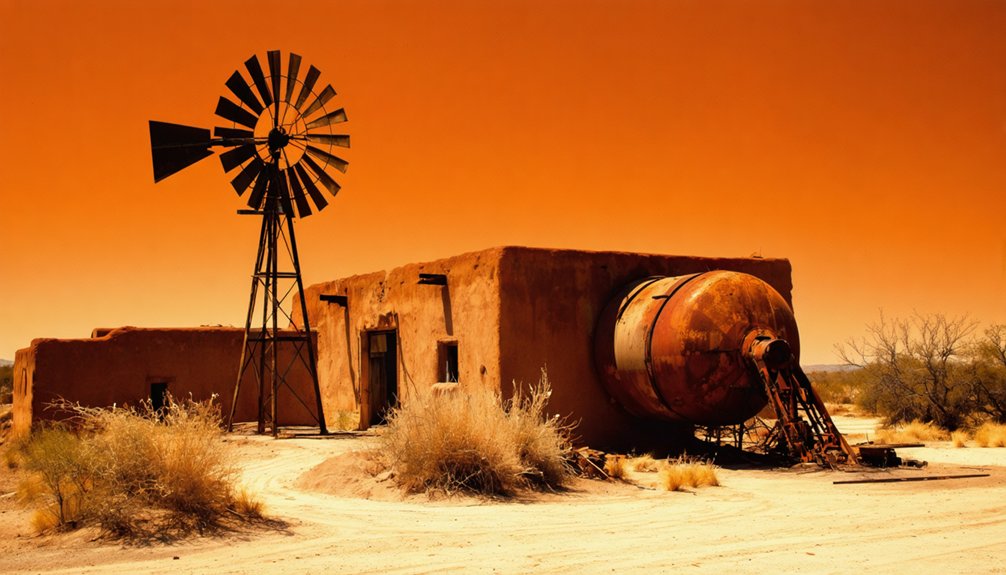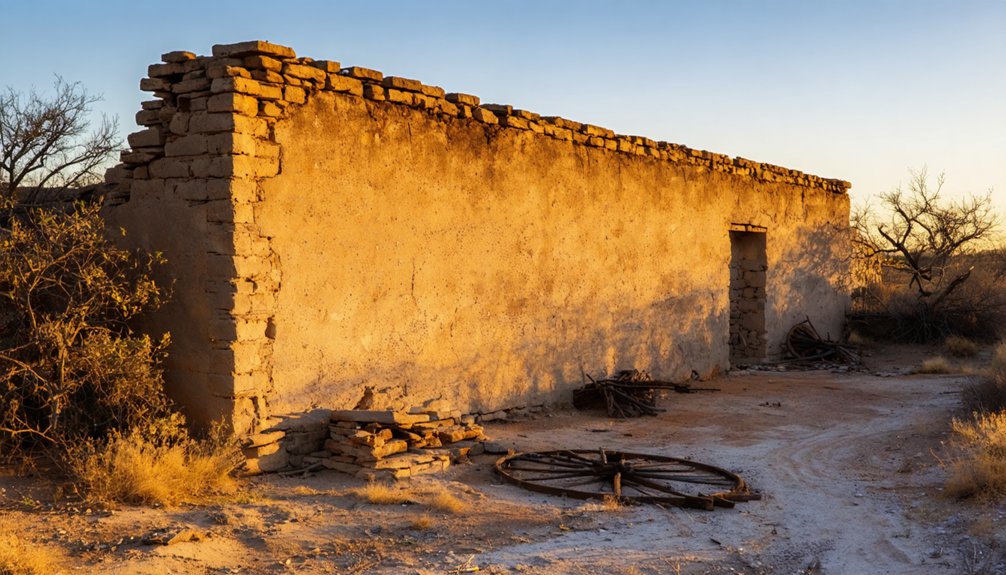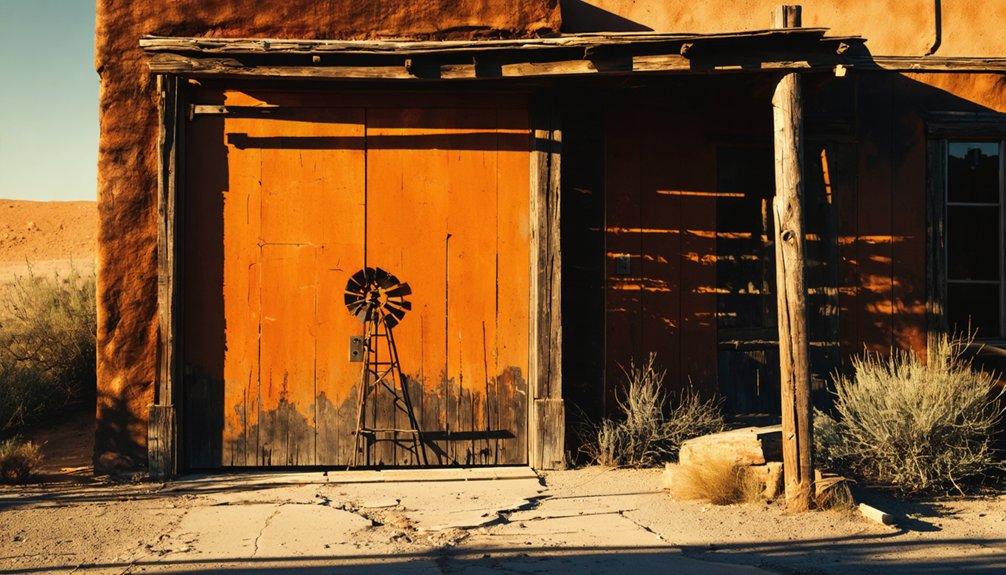You’ll discover Paso Real’s crumbling adobe foundations along Texas’s Rio Grande, marking an 18th-century Spanish colonial settlement that once protected against Apache raids. The town thrived as an essential crossing point until an 1829 flood altered the river’s course, leading to its decline. Today, historical markers chronicle its past amid the harsh Chihuahuan Desert landscape, where temperatures soar above 100°F. The site’s scattered remnants tell a deeper story of frontier survival and cultural exchange.
Key Takeaways
- Paso Real was an 18th-century border settlement along the Rio Grande that served as a strategic point between Spanish territories and Apache lands.
- A devastating flood in 1829 altered the Rio Grande’s course, leading to Paso Real’s initial decline as a settlement.
- Archaeological remains include adobe foundations and Spanish colonial architecture, with an old El Paso bridge marking its transportation history.
- Historical markers document Paso Real’s significance, though limited preservation efforts have left the town in a largely abandoned state.
- The settlement’s decline was further accelerated by changing political boundaries following the U.S.-Mexico War in the mid-19th century.
The Rise and Fall of a Border Settlement
While the exact founding date remains uncertain, Paso Real emerged as an essential border settlement in the El Paso region during the 18th century, strategically positioned along the Rio Grande between Spanish territories and hostile Apache lands.
You’ll find its origins tied to Spanish presidios, built to protect settlers from relentless Apache raids that shaped the settlement dynamics of the region. During this period, Apache livestock raids became increasingly common as drought conditions intensified after 1760.
The settlement’s strategic location fostered diverse cultural influences as it became a significant hub for trade and agriculture. Like nearby Hueco Tanks, the area experienced a milder climate with cooler summers and greater rainfall during this early period.
However, Paso Real’s prominence wouldn’t last. A devastating flood in 1829 altered the Rio Grande’s course, while persistent Apache raids continued to destabilize the community.
Following the U.S.-Mexico War, shifting political boundaries and Anglo-American migration further transformed the settlement, ultimately contributing to its decline and abandonment.
Life in the Chihuahuan Desert
In the unforgiving Chihuahuan Desert environment, you’d face daily survival challenges that demanded careful adaptation to extreme temperatures ranging from winter freezes to scorching summer heat waves above 100°F. Dust storms and blowing dust frequently made travel and daily activities hazardous. The high evaporation rates made conserving precious water resources even more crucial for survival.
You’d learn quickly that the desert’s scarce rainfall, typically only 225-275mm annually, made securing reliable water sources your most critical priority.
Your success depended on mastering techniques used by earlier settlers: locating natural springs, digging wells in seasonal creek beds, and harvesting the brief but intense summer monsoon rains that delivered up to 80% of the year’s precipitation between July and October.
Desert Survival Challenges
Surviving the harsh conditions of the Chihuahuan Desert presents formidable challenges that have shaped both human and animal adaptations throughout Paso Real’s history.
If you’re exploring these lands, you’ll need to master the same desert survival techniques that local wildlife employs. When temperatures soar above 100°F, you must seek shelter in shaded areas with proper airflow, just as the Kit Fox retreats to its den during scorching daylight hours.
For effective heat management, you’ll want to follow the example of desert creatures by limiting your activity to cooler periods. Black-tailed jackrabbits demonstrate how large ears help regulate body temperature in extreme desert conditions. The region’s once abundant native plant life has diminished significantly due to overgrazing, making it harder to find natural food sources.
You’ll find the most success by adopting their proven strategies: conserving water, utilizing natural shelters like rock formations, and maintaining a stable body temperature through careful planning and minimal exposure to peak heat.
Water Source Adaptations
Beneath the arid expanse of Paso Real lies an intricate network of groundwater systems that’s vital to the region’s survival.
You’ll find that successful water conservation efforts here have always depended on understanding the delicate balance between surface and subsurface water sources. The Rio Grande-Rio Bravo system, along with local springs and streams, creates a lifeline for both wildlife and human settlements.
Key adaptations for groundwater management in Paso Real include:
- Strategic placement of wells to tap into underground aquifers without depleting the water table
- Development of water-sharing agreements between agricultural operations and natural ecosystems
- Implementation of monitoring systems to track groundwater levels and prevent over-extraction
These adaptations have proven essential in maintaining the region’s ecological integrity while supporting human needs in this challenging desert environment.
Architecture and Remnants
Architectural remnants of Paso Real offer glimpses into Texas frontier life through scattered adobe foundations and weathered building materials.
You’ll find traces of Spanish colonial influence in the crumbling walls and traditional vigas that once supported roofs throughout the settlement. The town’s original layout, centered around a main thoroughfare, reflects the typical organization of early Texas settlements. The discovery of an old El Paso bridge nearby indicates the town’s importance as a transportation hub. Much like the lead contaminated grounds that plagued Smelter Town residents, the soil here holds stories of industrial impact.
While architectural preservation efforts have been limited, you can still discover historical markers that chronicle the town’s past.
Weather-worn foundations reveal how early settlers adapted their building techniques to the harsh climate, using local materials like adobe brick and wood. The remaining structural elements showcase a blend of Spanish, Mexican, and frontier architectural styles that defined this once-thriving Texas community.
Agricultural Heritage
Along the Rio Grande at Paso Real, you’ll find evidence of early irrigation systems that once sustained farming in this challenging desert environment.
The settlers who lived here had to carefully manage their water resources, digging irrigation ditches that branched from the river to support both crops and livestock in the arid climate. With only 7.77 inches annually of rainfall, the community relied heavily on these irrigation networks for survival.
Local ranchers adapted their grazing patterns to the seasonal conditions, moving cattle between the river bottomlands and surrounding desert scrubland as water availability dictated. The ranch operations drew upon centuries-old traditions from Spanish missionaries, who established the first cattle raising ventures in the Rio Grande Valley.
Irrigation Along Rio Grande
The Rio Grande’s agricultural heritage traces back to three distinct periods of irrigation development: pre-colonial Native American practices, Spanish colonial innovations, and American settlement expansions.
You’ll find that early irrigation methods shaped the cultural heritage of communities along this mighty river, as Pueblo Indians first developed simple water management systems that Spanish settlers later enhanced.
- Native American farmers constructed basic irrigation channels along the Rio Grande, laying the groundwork for future agricultural development.
- Spanish colonists introduced more sophisticated irrigation techniques, including acequias and water-sharing systems.
- American settlers expanded these systems in the 19th century, building dikes and canals that transformed the valley’s agricultural potential.
The region’s water management evolved through public irrigation districts, supporting growing communities and establishing the foundation for modern farming practices.
Desert Farming Challenges
Since farming began in the Trans-Pecos region nearly 3,000 years ago, desert farmers have faced extraordinary challenges in cultivating crops within harsh environmental conditions.
You’ll find that early farmers struggled without modern irrigation technology, relying heavily on unpredictable flood cycles and limited well water to sustain their crops.
To overcome these obstacles, farmers adopted innovative techniques like crop rotation and soil conservation. They’ve had to carefully select drought-resistant varieties and adapt their growing methods to the desert climate.
By the early 1900s, you could see significant technological advances, including steam-engine pump houses that transformed farming capabilities.
While land values skyrocketed from 25 cents to $300 per acre between 1906 and 1910, success still depended on mastering water management and understanding the desert’s unique demands.
Livestock Grazing Patterns
During the mid-1500s, Spanish colonists transformed the agricultural landscape of Paso Real by introducing cattle, sheep, and horses from Mexico.
You’ll find that early herding concentrated near established settlements due to native conflicts, with missionaries later expanding livestock operations along the Rio Grande.
When Spain retreated in 1767, Anglo ranchers like Milton Faver pioneered new cattle operations in the region.
Key changes in livestock sustainability and grazing regulations emerged:
- The Taylor Grazing Act established permits tied to property ownership
- Open-range practices gave way to regulated systems with mandatory fees
- Ranchers adapted grazing patterns to combat drought and soil degradation
You’ll notice how European settlers initially applied familiar but unsuitable grazing practices in these semi-arid lands, leading modern ranchers to embrace longer recovery periods and adaptive management strategies.
Trade Routes and Rio Grande Connection
Located at a strategic point along the Rio Grande River, Paso Real emerged as an essential hub within the complex network of trade routes connecting the United States and Mexico.
You’ll find the town’s trade history deeply intertwined with the river’s role as both a transportation corridor and a natural border. The waterway facilitated extensive cultural exchange between Native American tribes, Spanish settlers, and American traders who converged in this dynamic region.
The Rio Grande’s waters didn’t just define political boundaries – they powered the area’s economic engine.
You’re walking in the footsteps of countless merchants who used these routes to transport goods between major commercial centers. Spanish explorers initially mapped these pathways, establishing a foundation for the robust trading network that would shape Paso Real’s destiny.
Environmental Challenges

While Paso Real once thrived as a trade hub, the town’s environmental legacy tells a sobering story of industrial contamination and climate-driven challenges.
You’ll find the ASARCO smelter’s toxic footprint in the soil and groundwater, where metals and diesel fuel contamination have created lasting impacts requiring extensive pollution prevention measures.
The region’s water scarcity compounds these concerns, as drought conditions intensify and aging infrastructure struggles to meet demands.
Chronic water shortages grip the region as worsening droughts and deteriorating water systems create a mounting resource crisis.
- Groundwater contamination from heavy metals flows westward toward the Rio Grande, threatening cross-border water quality
- Record heat waves and flash flooding events challenge local infrastructure and ecosystem stability
- Contamination cleanup efforts face complex challenges from mixed pollutants, while dust from degraded soils poses ongoing health risks
Ghost Town Experience Today
Today’s visitors to Paso Real will find little more than scattered debris and possible building foundations, as this once-bustling trade hub has surrendered almost completely to nature’s reclamation.
If you’re planning ghost town exploration here, you’ll need to navigate without amenities, signage, or maintained roads. Unlike popular Texas ghost towns that host festivals or offer guided tours, Paso Real remains largely forgotten in cultural memory.
Before venturing out, you’ll want to determine land ownership and secure necessary permissions to avoid trespassing. You won’t find any commercial services, utilities, or infrastructure at the site.
The area’s unmarked nature and lack of documentation mean you’re truly stepping into raw, abandoned territory – a stark reminder of how completely a community can vanish from the landscape.
Historical Significance in Texas Borderlands

The rich history of Paso Real reveals deep connections to centuries of borderland dynamics between indigenous peoples, Spanish colonizers, and later Mexican settlers.
You’ll find a cultural heritage deeply rooted in the region’s complex interactions between Mescalero Apache, Spanish presidios, and evolving settlement patterns that shaped Texas’ borderlands.
- Paso Real’s strategic location made it a focal point of indigenous influence, where Apache groups maintained control through raids and resistance until 1880.
- You’re walking through land that witnessed Spanish colonial efforts to establish presidios and missions, creating a network of settlements that transformed the frontier.
- The area’s significance grew during Mexico’s independence when it fell under Chihuahua’s jurisdiction, though floods and changing river courses would later alter its destiny.
Frequently Asked Questions
Are There Any Documented Paranormal Activities or Ghost Sightings in Paso Real?
You won’t find documented ghost stories or haunted locations for Paso Real, as there’s no credible evidence of paranormal activity in historical records, local testimonies, or paranormal databases.
What Happened to the Last Families Who Lived There?
Like tumbleweeds scattered by the wind, you’ll find no clear records of Paso Real’s last families – they likely drifted away gradually during the 1930s as farming opportunities dried up.
Can Visitors Legally Collect Artifacts From the Site?
You can’t legally collect artifacts without proper permits due to federal and state legal regulations. Instead, you’re encouraged to document findings through photos while supporting artifact preservation efforts.
Were There Any Notable Crimes or Outlaws Associated With Paso Real?
You’ll find notable criminals used Paso Real as a hideout during border conflicts, with historical incidents of horse theft, banditry, and stagecoach robberies along the region’s travel routes.
How Did Native American Tribes Interact With the Paso Real Settlement?
You’d think native tribes near Paso Real enjoyed peaceful cultural exchanges, but they mostly engaged in hostile relations, with Apache raids common, though some groups like Carrizos established limited trade relations.
References
- https://usghostadventures.com/el-paso-ghost-tour/
- https://borderzine.com/2012/11/smelter-town-–-a-personal-look-at-a-ghost-town-firmly-embedded-in-el-paso-history/
- https://mix941kmxj.com/see-how-two-texas-ghost-towns-battled-for-the-county-and-lost/
- https://www.texasbeyondhistory.net/hueco/story.html
- https://www.youtube.com/watch?v=q5wnpQpgOzQ
- https://en.wikipedia.org/wiki/List_of_ghost_towns_in_Texas
- https://www.tshaonline.org/handbook/entries/paso-real-tx
- https://www.texasescapes.com/WestTexasTowns/Devils-River-Texas.htm
- https://www.texasbeyondhistory.net/paso/history.html
- https://en.wikipedia.org/wiki/Smeltertown



